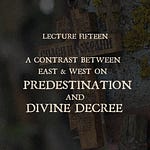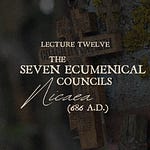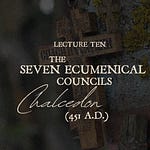These are transcripts from a spoken lecture. The audio is attached to this lesson. If there is any confusion from reading the transcript, please refer to the audio for clarification.
Last time we talked about the Council of Constantinople (381 AD) and we talked about the doctrine of the Holy Trinity as developed there. So we had seen in Nicaea, there was an insistence that the second person of the Trinity, the Son of God, has the same nature as God the Father. And in Constantinople, we saw the formal articulation of what this doctrine really looks like. When you’re talking about the Trinity, you have three discrete individuals or particulars or subjects—three hypostases: Father, Son and Holy Spirit—that are absolutely distinct, but they share a common nature. And what we also saw is that these three are really one God, but not one God in the sense that they’re somehow collapsed, that they’re parts of a whole, or they’re one guy with several masks, but rather the One God refers to the one common divinity shared between them, just as you and I and another human person here would be one human, as Gregory of Nyssa put it, that we share a common humanity, so they share a common divinity.
And yet we also saw that there were critical differences between us as creatures and God, namely, that all of the differentiations between us are really material. So we are not just distinct, but we’re separate. We’re spatially separated because we have material bodies, and how we’re differentiated one from another is also based on this materiality, the fact that you have accidental properties and so do I. We’re different sizes, we’re in different positions, different locations, different colors, and so on and so forth. And none of that applies to the persons. But that, of course, raised the question, what differentiates the persons? How are they differentiated? If they’re not differentiated by physical characteristics, what does differentiate them? How do we tell Father apart from the Son, for example?
And we saw that the differentiation was rooted in the one idiosyncratic property that each of the persons have. The Father’s idiosyncratic property is that he begets the Son. The Son’s idiosyncrasy is that he’s begotten, and the Spirit’s idiosyncrasy is that he is out-breathed or spirated, or proceeds from the Father, and we saw that these are causal terms. That within the Holy Trinity, what we see is that the divine nature is native to the Father. It is his nature, and he is uncaused. He is unbegotten, he is ungenerated, but he gives that nature by generation to the Son, and he out-breathes the Spirit—different type of causation—but both of them are caused, and they are caused by the Father to have that nature.










